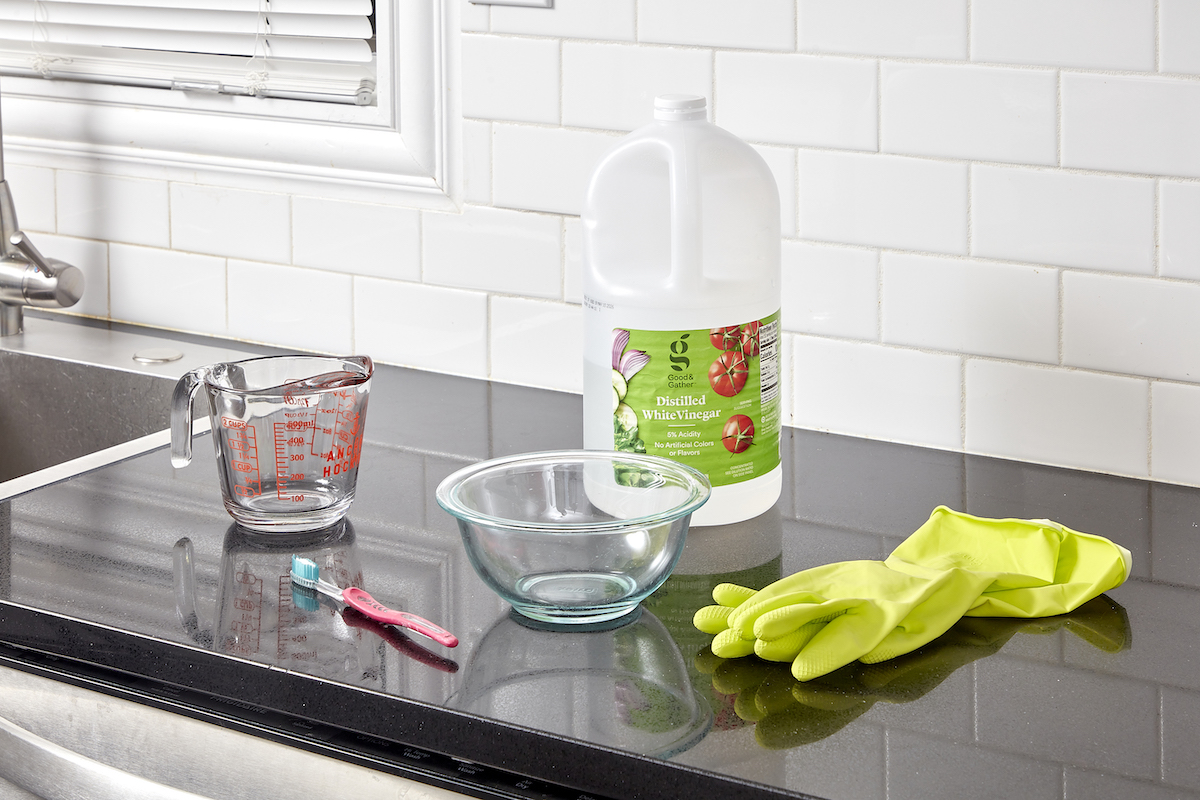

We may earn revenue from the products available on this page and participate in affiliate programs. Learn More ›
At first, the idea of cleaning a dishwasher, an appliance that fills with suds and water on an almost daily basis, may seem a bit strange. But think of it this way: You regularly maintain your vacuum, right? Well, the dishwasher shouldn’t be any different. Just as dust and debris can clog and hinder the performance of your vacuum, food scraps, soap scum, and stubborn grease can compromise your dishwasher.
Even if you have installed a new unit recently, you should know how to clean a dishwasher in order to eliminate grime and unpleasant odors and maximize its efficiency. Follow these simple steps to learn how to clean your dishwasher to keep it sparkling clean, sweet smelling, and in optimal working order.

Tools & Materials
Bobvila.com may earn a commission from purchases made through these links.
Step 1: Access and clear the dishwasher drain.
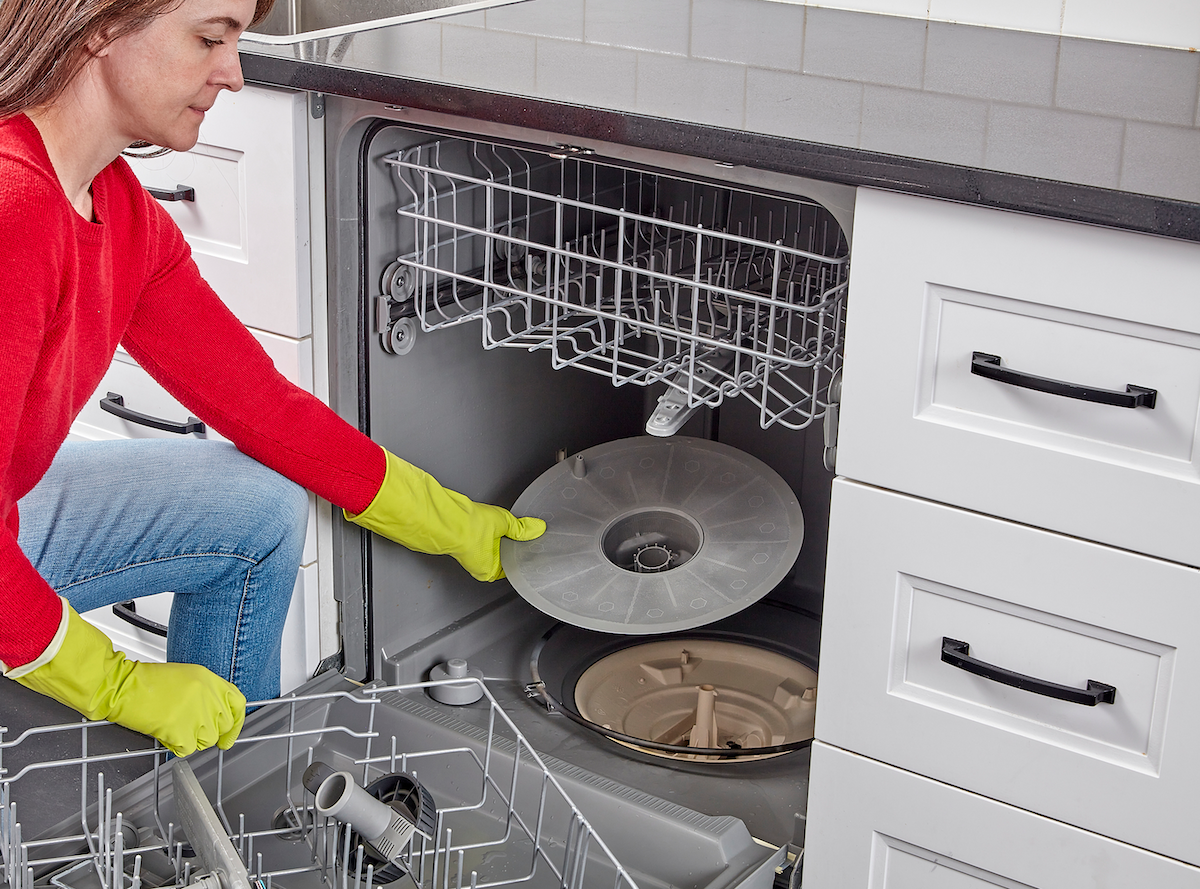
Pull out and remove the bottom rack. Wearing rubber gloves, thoroughly examine the area around the drain, and remove any gunk or chunks you find. (This debris not only impedes drainage, it also can damage the appliance.) While you’re at it, if your dishwasher has a removable filter, take it out and clean it. Run it under warm soapy water, and if necessary scrub lightly with a sponge or an old toothbrush. Clean the area around the filter before you replace it.
Step 2: Place a cup of vinegar in the dishwasher.

Fill a dishwasher-safe container with 1 cup of white vinegar, and place it on the upper rack of the otherwise empty machine.
Step 3: Run the dishwasher through a hot-water cycle.

Close the door and run the dishwasher through a hot-water cycle.
Once the vinegar has worked its magic, you should open the door to a pretty clean dishwasher. Most, if not all, of the grease and grime will have washed away, and any musty odors should be gone.
Step 4: Complete a short rinse cycle with baking soda.
Sprinkle a cupful of baking soda across the bottom of the appliance, then run it on a short hot-water cycle. Whatever food smells weren’t wiped out with vinegar will be absorbed by the baking soda, the same way they are when you place a box of Arm & Hammer in the fridge.
The slightly abrasive nature of baking soda will act like a scrub for the appliance too. When the cycle’s done, you should notice that your fresh-smelling dishwasher now boasts a brightened, stain-free interior. Don’t try to skip a step and place the baking soda and vinegar in your dishwasher together; you might end up with a mess.
Step 5: If there’s additional mildew or mold in the dishwasher, consider running a cycle with bleach.
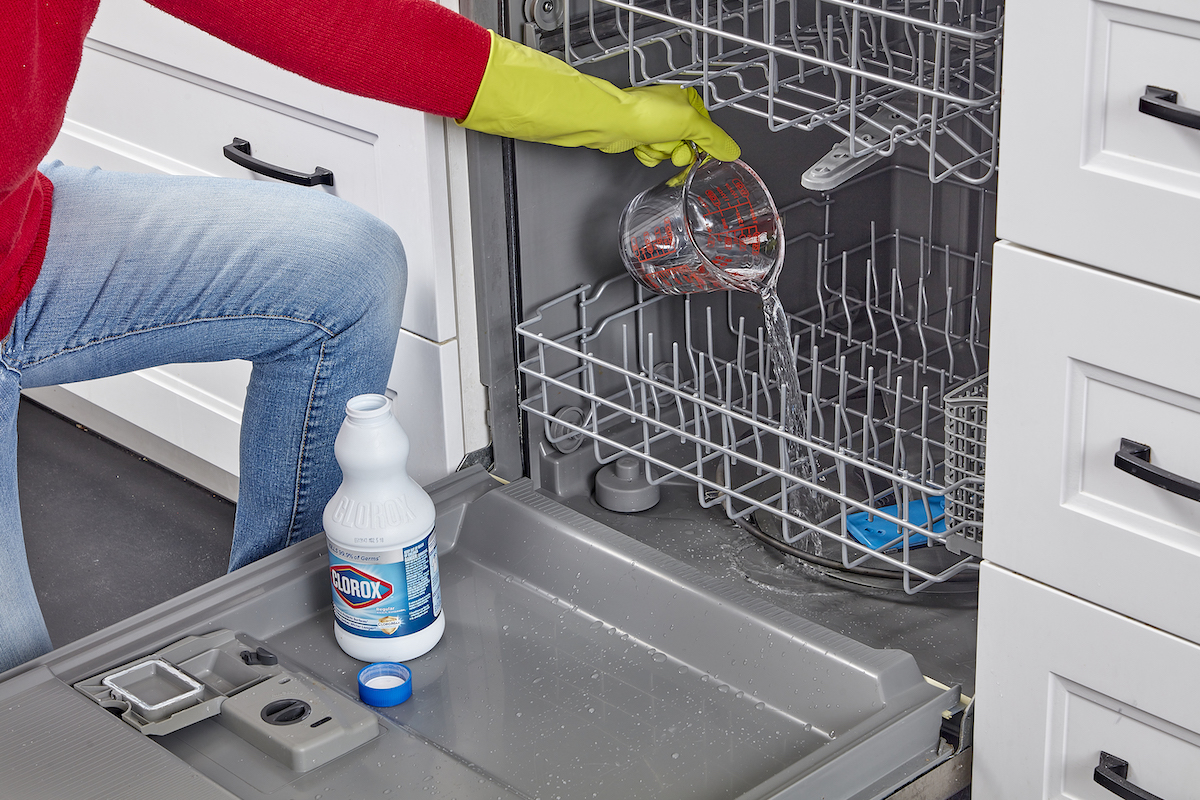
This step is optional. Complete it only if your dishwasher still contains mold or mildew after you’ve finished the previous steps.
If your dishwasher has suffered a vicious attack from nasty mold, vinegar can kill mildew, but some dire cases may require the cleansing power of bleach. Never use bleach on a dishwasher with a stainless steel interior or stainless steel parts. Bleach and stainless steel are not friends. If your stainless steel dishwasher still has mold and mildew after you’ve run cleaning cycles, try another vinegar cycle as instructed in Step 2.
For dishwashers that can be cleaned with bleach, pour 1 cup of bleach in the bottom of the dishwasher, or put a cup of bleach in a dishwasher-safe container in the top rack, then run the machine for a full cycle at the hottest setting.
Step 6: Clean the dishwasher’s seal and exterior.
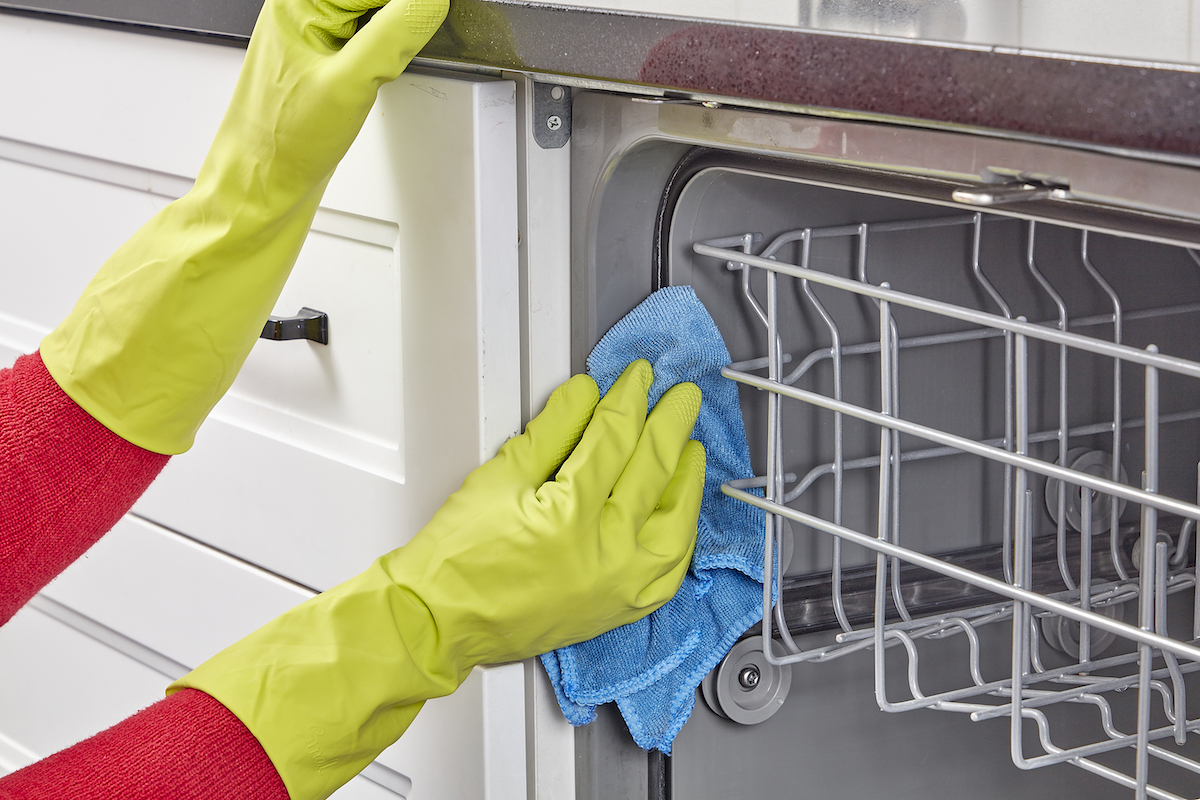
Repeat the above steps every 1 to 2 months, and you’re likely to add years of service to this hardworking machine that tackles your least favorite chore. One more tip: When you clean your dishwasher, don’t forget to wipe down the sides and top of the door as well as the seal between the door and the tub; water does not reach these areas during a cycle. Finally, wipe down the exterior of the appliance. Remember, a clean dishwasher is an effective dishwasher.
How Cleaning a Dishwasher With Vinegar and Baking Soda Works
A natural cleaner with many talents, white vinegar takes care of two big problems that often plague dishwashers: clogs and smells. Count on it to cut through grease lining the walls of the dishwasher after endless loads of dirty dishes, clear away old detergent buildup, and even dissolve mineral deposits—all of which could one day clog the plumbing and cause your appliance to underperform. The fact that white vinegar neutralizes food odors so your dishwasher won’t smell is a bonus.
Like vinegar, baking soda is great at tackling odors, but it also has stain-fighting abilities. Because it’s lightly abrasive, baking soda is effective at loosening stains and built-up grime. When you clean your dishwasher with vinegar and baking soda, you’re aiming a powerful one-two punch at the food deposits, grease, and odors that accumulate in your dishwasher over time.
When cleaning a dishwasher, you can achieve similar results by using a package of unsweetened lemonade mix instead of vinegar. Simply pour the powder into the detergent dispenser and run a wash cycle. The citric acid in the lemonade mix works in much the same way as vinegar, cutting through lingering food particles.
When shopping for lemonade mix, look for unsweetened lemonade, and be sure that citric acid is on the list of ingredients. Don’t get fancy with your lemonade flavors, either; varieties like strawberry and raspberry can leave stains. If you don’t have lemonade mix handy, try running a cycle with a cup of lemon juice in a dishwasher-safe bowl in the top rack of the dishwasher.
Tips for Maintaining a Clean Dishwasher
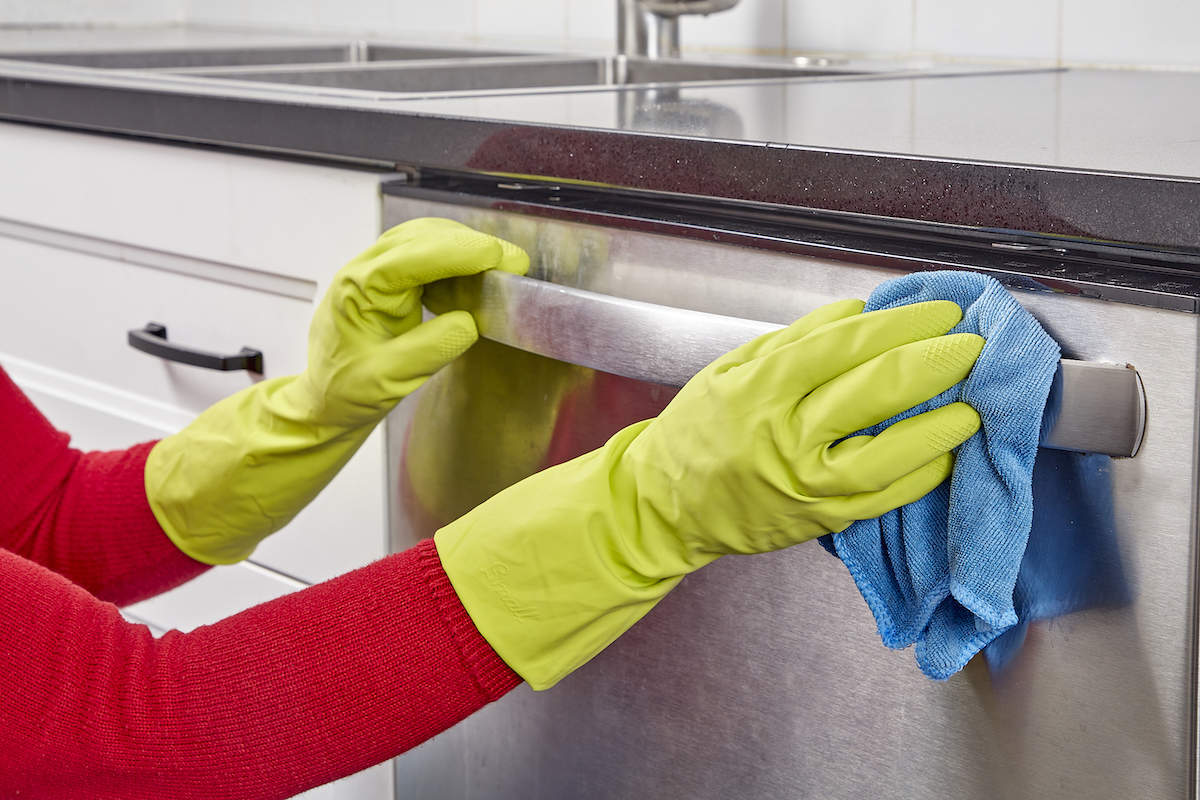
Now that you know how to clean your dishwasher, perhaps the best way to keep it looking great and working well is to treat it with respect and consideration day in and day out—after all, the machine isn’t invincible.
Observing a few simple usage guidelines can help you wring the best possible performance from this workhorse appliance, even as you prolong its lifespan.
- The dishwasher shares a drain with the kitchen sink. If you have a garbage disposal, run it before starting a cycle to ensure that the drain is clear.
- It’s smart to conserve electricity and water by running the dishwasher only when it’s full, but resist the temptation to pile dishes too high or too tightly. This prevents the sudsy water from traveling around all sides of each dish and getting your load completely clean.
- Don’t prewash dishes too thoroughly before adding them to the dishwasher. For dishwasher detergent to do its job effectively, there needs to be some grease and food residue present. Otherwise, the detergent simply creates foam during the wash cycle, and that excess can be detrimental to the appliance.
Final Thoughts
If you’ve ever wondered how to clean a dishwasher, you now know the best way to tackle this chore. To keep the appliance working well and odor-free, clean it every 1 to 2 months. Cleaning a dishwasher is simple: just remove any dishes and run a cycle, using a natural cleaner like white vinegar, baking soda, or lemon juice. As an alternative, put unsweetened lemonade mix in the detergent dispenser; the citric acid cuts through grease and grime.
If the dishwasher has stubborn mold or mildew, run a cycle with a cup of bleach in the top rack. But do not do this if your dishwasher has a stainless steel interior or stainless steel parts. Bleach damages stainless steel surfaces.
If, despite your best efforts, your dishwasher’s performance keeps sliding, or if its interior is cracked or starting to rust, it may be time for a new dishwasher. Upgrading has its benefits: Newer models tend to be quieter, and they’re stingier with water and energy.
FAQs
Bleach is great for disinfecting and getting rid of mildew and mold in the dishwasher. That said, bleach damages stainless steel surfaces, so it should never be used in a dishwasher with a stainless steel interior or stainless steel parts.
Clean your dishwasher with vinegar every month or so. If you notice odors or a buildup of food residue on the bottom of the appliance, or if your dishes are still dirty after they’ve been through a cycle, clean the dishwasher more frequently.
There are many options for cleaning a dishwasher without vinegar. Just start with an empty dishwasher and run a cycle using any of the following: a packet of unsweetened lemonade mix, emptied into the detergent dispenser; a cup of lemon juice in a dishwasher-safe bowl, placed in the top rack; a cup of baking soda sprinkled on the bottom of the machine.
Alternatively, try a product specially formulated for cleaning dishwashers, such as Affresh or Finish Dishwasher Cleaner.
All dishwashers have filters. Some have self-cleaning filters, while others have manual filters that need to be removed and cleaned by hand. Older dishwashers are more likely to have self-cleaning filters; newer models tend to have manual filters.
Even if your dishwasher has a self-cleaning filter (check the manual), you still must periodically clean out the bottom of the dishwasher to get rid of chunks of food, broken glass, and other debris. Consider wearing gloves for the task. A toothbrush is handy for scrubbing off stuck-on residue.
Manual filters need to be removed and cleaned every 1 to 2 months, more frequently if you notice odors, food residue, or a decrease in efficiency. Clean your dishwasher filter according to the manufacturer’s instructions. In general, slide out the bottom rack and remove the filter, a cylindrical piece that will probably have arrows on it indicating which direction to twist.
Hand-wash the filter in warm soapy water. If necessary, scrub with a soft sponge or old toothbrush. Before you reinstall it, clean the area where the filter sits, removing any food particles and wiping down with a rag, if necessary.
